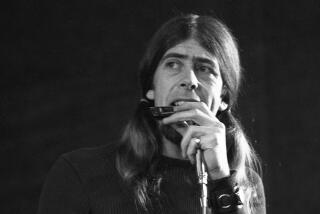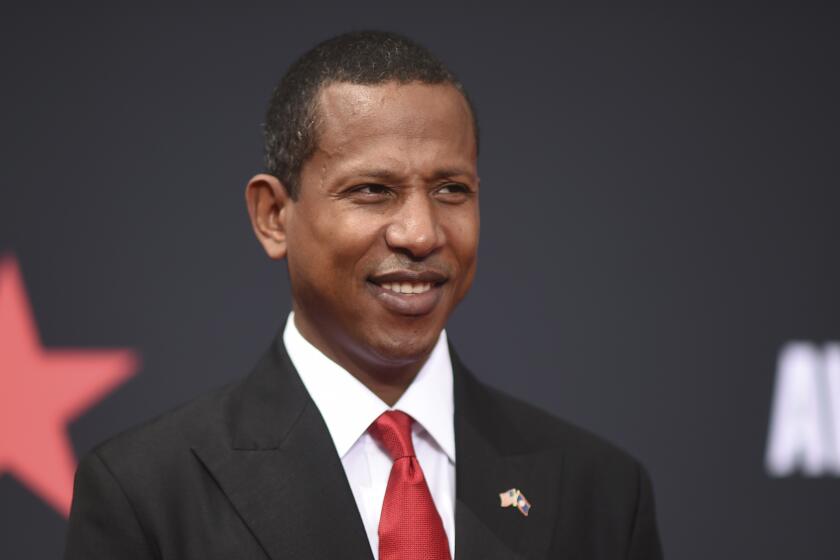Marsalis, Sure, but Monk Too
A âsoft yearâ is the way 1997 is being described by people around the record business. And when itâs soft for mega-selling pop music, itâs soft for smaller categories such as jazz and classical music.
But despite a drop-off in sales, major jazz labels such as Blue Note continued to function profitably as they began developing audiences for an emerging generation of artists, among them performers such as pianists Laurent de Wilde, Jacky Terrasson, Geoff Keezer and Brad Mehldau, saxophonists Javon Jackson, Don Braden and David Sanchez, and singer Diana Krall.
Perhaps more to the point--especially from a Southern California perspective--1997 was a year filled with a number of important, upbeat developments for jazz.
The most potentially significant event was the announcement in May of a partnership between the Thelonious Monk Institute of Jazz and the Music Center. Although it was described as a long-term program that will place jazz in a position equal to that of the other creative arts present at the Music Center, developments have been slow in arriving. But Decemberâs gala concert at the Dorothy Chandler Pavilion appeared finally to open the door to a productive new year for this pivotal relationship for jazz in the Southland.
CONCERT SCENE: Attractive, innovative jazz programs arrived throughout the year. There were jazz entries in every major concert series around the Southland, from Cerritos and Orange County to the Hollywood Bowl, UCLA and Thousand Oaks. The summer schedule was filled with free jazz at places such as the L.A. County Museum of Art, Museum of Contemporary Art, Armand Hammer/UCLA and the downtown Water Court.
The concert year began impressively with the Music Center performance of Wynton Marsalisâ Pulitzer Prize-winning oratorio, âBlood on the Fields.â Although the sometimes long-winded work had its problems, it nonetheless represented a major breakthrough for jazz as a medium for a large aesthetic vision.
In June, at Redondo Beach, a Stan Kenton retrospective weekend presented a broad survey of music from every era in the legendary bandleaderâs career. In August, Charlie Haden brought his Quartet West and an orchestra to the Ford Theatre for an evening connecting jazz with film noir.
In September, the all-star duo of Herbie Hancock and Wayne Shorter brought a new take on jazz improvisation to the Alex Theatre. In October, there was an impressive celebration of Thelonious Monkâs 80th birthday by an ensemble led by his son, drummer T.S. Monk Jr., performing a program of his fatherâs classic jazz compositions. And guitarist John McLaughlin turned up at UCLAâs Wadsworth Theater in November with a superb program of jazz fusion.
AT THE CLUBS: Jazz club activity was also vitalized. Catalina Bar & Grill, one of L.A.âs two primary venues for national jazz-act appearances, was renovated in August, opening with an attractive, new, relaxed ambience. And, moving beyond the usual lineup of mainstream-oriented acts, owner Catalina Popescu brought in the world music-oriented Zawinul Syndicate and the hard-driving, funk-based Marcus Miller group, diversifying the clubâs image and drawing younger listeners.
The Jazz Bakery continued its balancing of name acts with one-nighters by local artists, presenting a rare performance by trumpeter Chuck Mangione and attractive appearances by the Marcus Roberts large ensemble, the Cyrus Chestnut Trio, the Cecil Taylor Trio and jazz harmonica player Toots Thielemans.
And there was active jazz stirring in other rooms as well. The redecorated and renamed Moonlight (formerly Moonlight Tango) continued its big-band bookings with performances by the Bill Holman ensemble and the appealing new Anthony Wilson Band. The House of Blues, bringing in jazz acts on a fairly regular basis, booked Sonny Rollins for two sold-out Saturday night shows, and Billboard Live, emphasizing contemporary jazz acts, presented Chick Corea and Michael Brecker. Club Brasserie in the Bel Age Hotel began booking occasional name performers with the appearance of saxophonist Greg Osby, and Steamers in Orange County maintains a full schedule of attractive jazz programming.
ON THE RECORD: 1997 saw an array of diverse new recordings, with much of the appeal generated by lesser known artists and established figures willing to take a chance on unusual musical combinations. Some of the more intriguing recordings were created by:
* Wynton Marsalis & the Lincoln Center Jazz Orchestra, âBlood on the Fieldsâ (Columbia/Sony). A three-CD rendering of the award-winning work, with inspired playing by the musicians and superb singing from Cassandra Wilson, Jon Hendricks and Miles Griffith.
* Herbie Hancock and Wayne Shorter, â1+1â (Verve). The veteran duo and close friends stretch the limits of what can be done in improvisational spontaneity be-tween piano and soprano saxophone.
* Gary Burton & Chick Corea, âNative Senseâ (Stretch). Another impressive all-star duo, with two players who seem to have an almost intuitive way of working together.
* Laurent de Wilde, âSpoon-a-Rhythmâ (Columbia). The French pianist (and author of a book on Thelonious Monk) is a gifted young artist with the rare ability to bring new ideas to the piano trio.
* Diana Krall, âLove Storiesâ (GRP). Rapidly establishing herself as one of the most gifted--and busiest--new jazz singers of the decade, Krall took time to sing a set of sensual love songs.
* Hilario Duran and the Cuban Jazz All-Stars, âKiller Tumbaoâ (Justin Time). A stunning set of performances by relatively unknown but improvisationally imaginative Cuban jazz players.
* Chucho Valdes and Irakere, âCubanismo Live!â (Bembe). Amid what is beginning to look like a deluge of superb Cuban music, there are no greater players than pianist Valdes and the great, veteran band, Irakere, performing here live, in concert.
It was also a remarkable year for jazz reissues and collections. Almost every major jazz artist is represented in the extensive array of boxed sets. Most are invaluable entries in anyoneâs shelf of jazz CDs. Among the best:
* John Coltrane, âThe Complete 1961 Village Vanguard Recordingsâ (Impulse!). A series of astonishing performances made when the influential saxophonist was at the peak of his powers.
* Benny Goodman, âThe Complete Small Groups on RCA Victorâ (RCA). Goodman, Gene Krupa, Teddy Wilson and Lionel Hampton, playing some of the classic small-group jazz of the â30s.
* Billie Holiday, âThe Complete Commodore Recordingsâ (GRP/Commodore). A set of the complete legendary Commodore studio recordings from the early â40s.
* Charles Mingus, âPassions of a Man: The Complete Atlantic Recordings (1956-1961)â (Rhino). Mingus at his most adventurous, leading some of his finest ensembles.
* Herbie Nichols, âThe Complete Blue Note Recordingsâ (Blue Note). A belated package that virtually encompasses the recording career of the sadly under-recognized pianist-composer.
* Joe Pass, âGuitar Virtuosoâ (Pablo). The great guitarist performs in solos, duos, with singers and ensembles in an impressive display of versatility.
* Sonny Rollins, âThe Complete Sonny Rollins RCA Recordingsâ (RCA). Recorded during a period in which Rollins was confidently defining the individuality of his music in the context of the emerging â60s avant garde.
* Lennie Tristano, Lee Konitz & Warne Marsh, âThe Complete Atlantic Recordings of Lennie Tristano, Lee Konitz & Warne Marshâ (Mosaic). Featuring the cool alternative jazz sound of the late â50s in what today sounds like thoughtful, imaginative improvising.
PASSINGS: Jazz once again lost some of its best-loved artists. Jazz violinist Stephane Grappelli died in December, shortly before what would have been his 90th birthday. A legendary artist whose workspanned virtually every decade of jazz, from the â20s to the â90s, Grappelli was a superb player with an artistic range that moved easily from elegant ballads to effervescently swinging up-tempos.
Others who passed away came from all arenas of jazz.
Singers: the blues shouter Jimmy Witherspoon, a veteran of the Count Basie Band, and jazz-tinged R&B; artist Arthur Prysock.
Saxophonists: the versatile tenor saxophonist Seldon Powell and the warm-toned singer and tenor saxophonist Big Nick Nicholas.
Trumpeters: Adolphus âDocâ Cheatham, another still-active senior, who died shortly before his 92nd birthday, only two days after his last performance, and the fine jazz improviser and sideman Rolf Ericson.
Guitarists: Chuck Wayne, best known for his work with George Shearingâs classic bop ensemble, and smooth jazz artist Zachery Breaux, whose career was just getting started.
Bassists: Carson Smith, a versatile performer who played with the Gerry Mulligan âpianolessâ quartet, and the gifted young artist Eric Von Essen.
Others: Spanish pianist âTeteâ Montoliu, the eccentric, jazz arranger-composer George Handy, and the hard-swinging organist Johnny âHammondâ Smith.
More to Read
The biggest entertainment stories
Get our big stories about Hollywood, film, television, music, arts, culture and more right in your inbox as soon as they publish.
You may occasionally receive promotional content from the Los Angeles Times.










